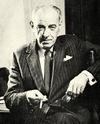The Powder Barrel: Difference between revisions
imported>Hayford Peirce (New article generated using Special:MetadataForm) |
imported>Hayford Peirce (brought in my template, so to speak, to get started with the next Haggard book, which I'm actually reading at the moment, so I am very much up to date) |
||
| Line 1: | Line 1: | ||
{{subpages}} | {{subpages}} | ||
{{TOC|right}} | |||
{{Image|William Haggard edited.jpg|left|100px|William Haggard on the back cover of [[The Conspirators]], 1967}} | |||
{{Authors|Hayford Peirce|others=y}} | |||
'''The Powder Barrel''' is a 1965 suspense novel by the British author [[William Haggard]] published in England by [[Cassell (publisher)|Cassell]] and in the United States by [[Ives Washburn]]. It was Haggard's seventh of 21 books involving his protagonist [[Colonel Charles Russell]], the urbane head of the unobtrusive but lethal Security Executive, a government counter-intelligence agency clearly based on the actual [[MI5]] or Security Service, where he moves easily and gracefully along [[C.P. Snow|C.P. Snow's]] [[Corridors of Power (novel)|Corridors of Power]] in [[Whitehall]]. Like Haggard's earlier books it has standard elements of suspense thrillers along with detailed examinations of character, but in this case with more scenes of direct action and somewhat less dissection of character and motivation than in the first three books. | |||
==Plot== | |||
''Protagonist'' is perhaps too strong a word to describe Colonel Russell. As Haggard himself wrote about his fiction: <blockquote>My novels are chiefly novels of suspense with a background of international politics. A Colonel Charles Russell of the Security Executive, a not entirely imaginary British counter-espionage organization, while not a protagonist in the technical sense, holds the story line together in the background by his operations, while the characters in the foreground carry the action."<ref>From the back flap of the dust jacket of the Walker and Company American edition of ''The Conspirators'', New York, 1967</ref></blockquote> | |||
As usual with Haggard's books, there are subplots within subplots, but the main theme is a simple one: | |||
==Reception and/or Appraisal== | |||
Reviews were very favorable: | |||
<blockquote>''The New York Times'' wrote: xxxx <ref>Anthony Boucher, ''Criminals at Large'', ''The New York Times'', August 30, 1964 at [https://timesmachine.nytimes.com/timesmachine/1964/08/30/119441118.html?pageNumber=118]</ref></blockquote> | |||
<blockquote>''Kirkus Reviews'' wrote: xcxxx <ref>''Kirkus Reviews'', August 1, 1964 at: [https://www.kirkusreviews.com/book-reviews/a/william-haggard-2/the-antagonists-4/]</ref></blockquote> | |||
==References== | |||
<references/> | |||
Revision as of 15:45, 16 October 2020
Authors [about]:
join in to develop this article! |
The Powder Barrel is a 1965 suspense novel by the British author William Haggard published in England by Cassell and in the United States by Ives Washburn. It was Haggard's seventh of 21 books involving his protagonist Colonel Charles Russell, the urbane head of the unobtrusive but lethal Security Executive, a government counter-intelligence agency clearly based on the actual MI5 or Security Service, where he moves easily and gracefully along C.P. Snow's Corridors of Power in Whitehall. Like Haggard's earlier books it has standard elements of suspense thrillers along with detailed examinations of character, but in this case with more scenes of direct action and somewhat less dissection of character and motivation than in the first three books.
Plot
Protagonist is perhaps too strong a word to describe Colonel Russell. As Haggard himself wrote about his fiction:
My novels are chiefly novels of suspense with a background of international politics. A Colonel Charles Russell of the Security Executive, a not entirely imaginary British counter-espionage organization, while not a protagonist in the technical sense, holds the story line together in the background by his operations, while the characters in the foreground carry the action."[1]
As usual with Haggard's books, there are subplots within subplots, but the main theme is a simple one:
Reception and/or Appraisal
Reviews were very favorable:
The New York Times wrote: xxxx [2]
Kirkus Reviews wrote: xcxxx [3]
